Semimembranosus Muscle: Anatomy, Origin, Insertion, Function, Exercise
Introduction
Semimembranosus is one of four posterior thigh muscles that are responsible for extending the hip, while It is also one of the three muscles to make a part of the Hamstring muscles group.
The other three muscles that belong to the hip extensor group are semitendinosus, biceps femoris, and gluteus maximus.
These three muscles semimembranosus, semitendinosus, and biceps femoris are referred to as the hamstring muscles.
Semimembranosus (along with semitendinosus) occupies the medial aspect of the posterior thigh.
It is a relatively long muscle that spans the full length of the thigh – from the hip to the knee.
Origin and insertion of Semimembranosus

- Semimembranosus is a relatively large muscle that originates from a small facet on the rough superolateral surface of the ischial tuberosity.
- The tendon of semimembranosus appears at the level of the mid-thigh and continues caudally toward the point of insertion at the medial condyle of the tibia.
- the main part that inserts on the medial tibial condyle, a second part that fuses with the popliteal fascia, and a third part that becomes the oblique popliteal ligament.
- Another important feature of semimembranosus is that its lateral border forms the superomedial wall of the popliteal fossa.
Relations
- Adductor magnus muscle (Musculus adductor magnus);
- The semimembranosus muscle has numerous adjacent muscular and neurovascular structures along its course.
- Semimembranosus is deep to semitendinosus, superficial to adductor magnus, and medial to biceps femoris along its entirety.
- The proximal part of the muscle is covered by gluteus maximus and medial to adductor minimus.
- Distally, semimembranosus crosses over and becomes medially related to the medial head of gastrocnemius before inserting on the medial tibial condyle.
- The distal portion of semimembranosus is also medial to the adductor canal (hiatus), which accommodates the vessels of the lower limb.
- There is a U-shaped bursa that encompasses the semimembranosus tendon. It separates the tendon from the medial tibial plateau, medial head of gastrocnemius, semitendinosus, and the medial cruciate ligament.
- The largest nerve in the human body – the sciatic nerve – travels lateral to semimembranosus until it reaches the apex of the popliteal fossa.
- At this point, the popliteal artery and vein are lateral to and partially covered by semimembranosus.
Innervation
- Semimembranosus is innervated by the L5, S1, and S2 nerve roots. These fibers access the muscle through the tibial division of the sciatic nerve.
Blood supply
- The femoral and popliteal arteries give off deep perforating branches that supply the semimembranosus muscle.
- The inferior gluteal artery supplies the proximal part of the muscle.
Palpation
- Semimembranous lies deep to semitendinosus and is difficult to palpate, but can be felt easier when the knee is flexed.
Functions
- Semimembranosus extends across both the hip and knee joints and is consequently responsible for multiple movements about the joints.
- Semimembranosus works in conjunction with the other hamstring muscles to carry out its function.
- When the feet are firmly planted on the ground, semimembranosus causes extension at the hip, which pulls the upper torso into an erect position.
- Semimembranosus (along with semitendinosus) can also cause internal rotation of the thigh when the hip is fully extended.
- When the legs are suspended off the ground, it causes flexion of the knee and internal rotation of the leg on the thigh.
- Semimembranosus and the other posterior thigh muscles are inactive whenever an individual is standing symmetrically.
- Once the individual tilts too far forward, semimembranosus is activated and counteracts the forward movement thus stabilizing the hip.
Stretching of Semimembranosus
- ‘The Forward Bend,Standing, (perform all of these movements in a relaxed way. There is no need to over-reach or force this stretch initially).
- The knees ‘locked out’ and the spine flat bend forward at the hips and just relax towards your toes, gently lengthening your hamstrings.
- To increase the intensity of the stretch, gently contract your quadriceps and reach for your toes, or try to place your hands upon the floor.
Hamstring Stretch:
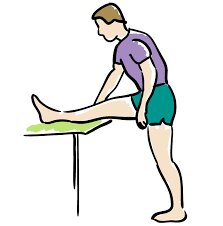
Standing upright, facing a bench, table, or horizontal bar, flex your hip to ‘lock out’ your knee, and place this straight leg upon the anchor point.
To increase this stretch, lean forward at the hip and reach toward the toes.
- Functional movements
- Stand from sitting
- Walking upstairs
- Standing jump forwards
- Standing jump upwards
Strengthening exercise of Semimembranosus:
Straight leg raise

- The patient is positioned supine with the hip and knee extended. One hand is placed over the anterior thigh to maintain full extension throughout the movement.
- The hip is flexed until firm muscular resistance to further motion is felt. A goniometer can then be aligned as follows:
- Stationary arm: Lateral midline of the trunk
- Axis: Greater trochanter of the femur
- Moving arm: Lateral epicondyle of femur
- Maximal hip flexion can then be documented.
Single-Leg Bridge
- Lie on the floor and place the heel of one foot on the edge of the bench so your leg forms a slighter wider than 90-degree angle.
- Extend the other leg straight up. Push into the heel on the bench and raise your hips up off the ground.
Lower your hips down for a single rep.
- Do 2 or 3 sets of 10 to 15 repetitions on each side.
- Advanced: You can make this move harder by placing a barbell or a weighed plate on your hips.
Box Squats:
- Stand in front of a bench, chair, or box that is 16 to 25 inches off the ground.
- Stand facing away from the box with a slightly wider stance and your toes slightly pointing out.
- Holding a weighed barbell in front of your chest and keeping your back firm, lower into a squat until your butt touches the surface. Return to standing. Do not let your knees go over the toes.
- One squat is a single rep. Do 10 to 15 reps 2 or 3 times.
One-Legged Deadlift:
- As you do this move, remember to keep your back straight and rotate from the hip.
- Holding a barbell or kettlebell in one hand, hinge forward at the hip, simultaneously extending the opposite leg straight behind you.
- Keep your back straight and lower your torso until your leg is parallel to the floor. If balance is an issue you can keep the toe of your back foot lightly touching the floor.
- Return to standing.
- Do 2 or 3 sets of 10 to 15 repetitions on each side.
Lying Leg Curls:
- This machine-based move is highly effective because it completely isolates the hamstring.
- When completing this move, be sure to focus on controlling the movement and go as slowly as possible, as you don’t want to use inertia to move the weights as you curl your feet closer to your rear.
Clinical Importance
HAMSTRING SYNDROME
- This pathology commonly affects athletes who present with localised pain near the ischial tuberosity.
- The pathophysiology is thought to be that of an insertional tendopathy at the ischium but there may also be involvement of sciatic nerve compression.
- The pain in hamstring syndrome radiates down the posterior thigh or popliteal region and is exacerbated when the hamstrings are on tension.
- This is often seen in sprinters or hurdlers. On examination there is exquisite tenderness over the ischial tuberosity and percussion in that region may reproduce the sciatic distribution of pain.
- Treatment involves rest, anti-inflammatory agents, and steroid injections.
Baker’s cyst
- The bursae that separate the muscle from the medial head of the tibia and the medial head of the Gastrocnemius may at times become enlarged with distended fluid.
- This swelling is termed ‘Baker’s cyst’.
FAQ
What is semimembranosus muscle?
Muscle of the semimembranosus (musculus semimembranosus) One of the four muscles in the posterior thigh that extends the hip is the semimembranosus. The biceps femoris, gluteus maximus, and semitendinosus are the remaining three muscles in the Knee flexor group.
What is the action for semimembranosus?
The hip joint is extended (straightened) by the semimembranosus muscle. It also causes the knee joint to flex, or bend. The tibia medially rotates on the femur when the knee is flexed, which also aids in medially rotating the knee.
Is the semimembranosus muscle anterior or posterior?
Posterior
A muscle located in the thigh’s posterior compartment is called the semimembranosus. It is situated in the medial aspect of the posterior thigh, deep to the semitendinosus muscle. Attachments: comes from the ischial tuberosity, which is a better place to start than the semitendinosus and biceps femoris.
What is another name for the semimembranosus?
Medial Hamstrings
By Any Other Name: The term “medial hamstrings” is frequently used to describe these muscles, as opposed to “lateral hamstrings (also known as the biceps femoris)”. The “Semi’s” are frequently shortened for them.
Why is semimembranosus called that?
One of the hamstring muscles in the thigh’s posterior compartment, the semimembranosus muscle is located next to the semitendinosus muscle on the medial surface of the thigh. Its ischial attachment’s flattened membranous tendon is the source of its name.
What is the semimembranosus muscle of the knee?
The lateral aspect of the ischial tuberosity is the starting point of the semimembranosus (SM) muscle, which flexes the knee and runs down the posteromedial portion of the thigh and knee.
Is semimembranosus a hamstring?
Situated on the inside (medial) side of the back of the thigh, the semimembranosus muscle is the deepest and innermost of the hamstring muscles. It passes nearly exactly beneath the semitendinosus, another hamstring muscle.

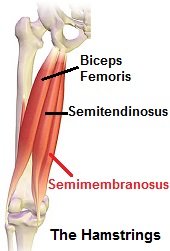

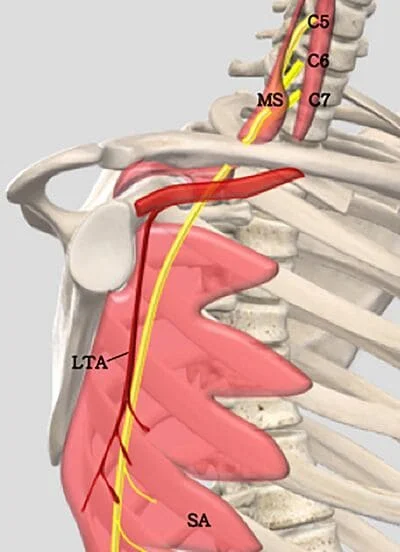
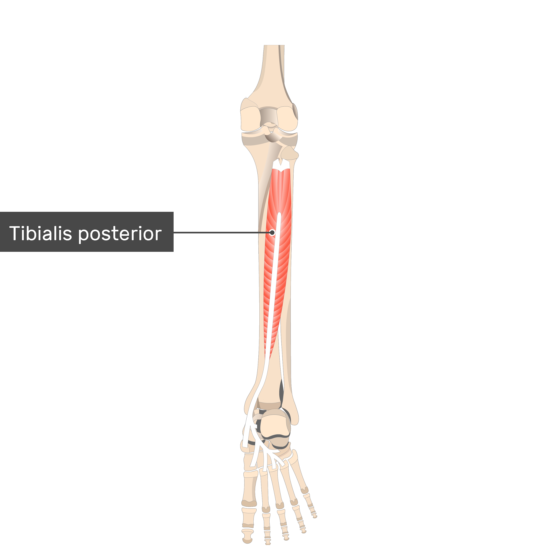
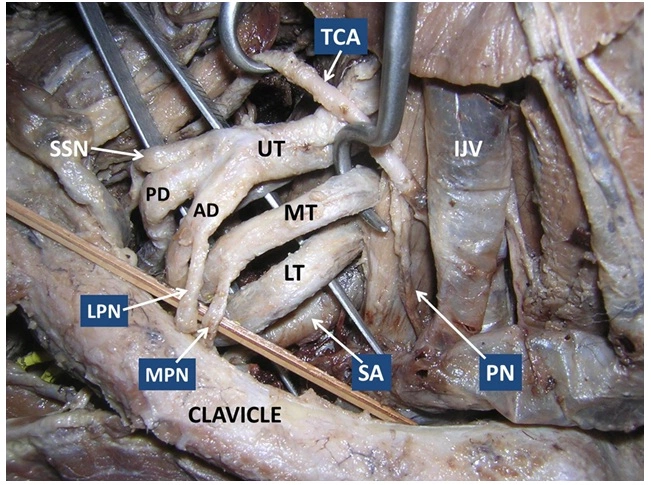
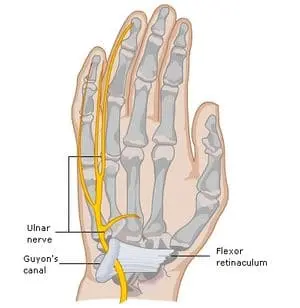
5 Comments